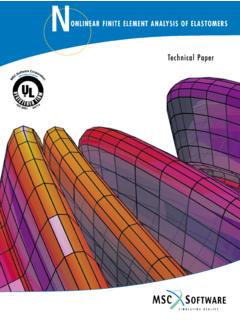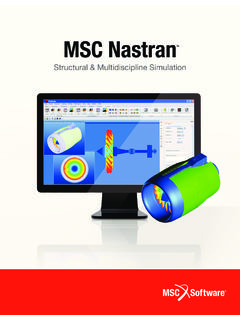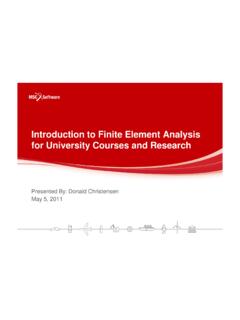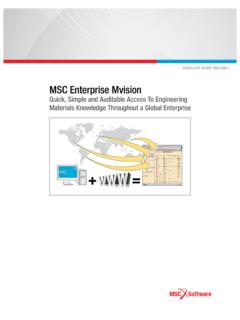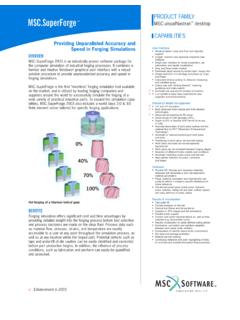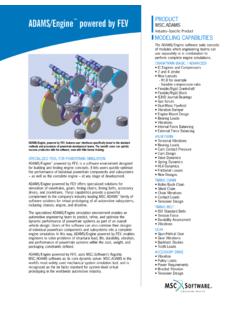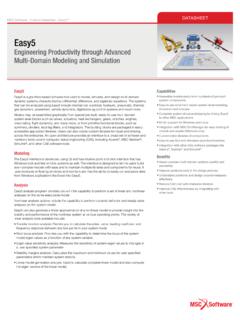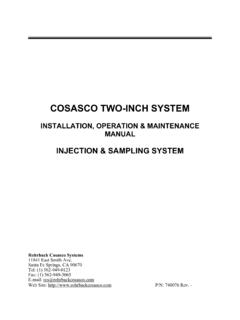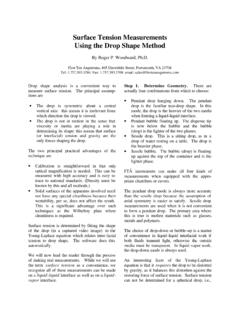Transcription of Improving the Ability to Simulate NVH in a Vehicle
1 Simulate MORE ACCURATELY Improving the Ability to Simulate NVH in a Vehicle Multidiscipline Simulation playing a key role in reducing factors contributing to noise & vibration Business challenges faced by automakers related to NVH MD Solutions 2 | Page Background Perception of a Vehicle s quality is generally tied to the vibratory and acoustic response of the Vehicle . In modern luxury cars, the overall noise levels are around 60 dB (A) at/or around 100 km/h speed. Hence N&V has been a focus of the automotive industry for the past several years.
2 Some of the challenges faced by automotive manufacturers include: a. Maintain a brand related acoustic signature: A customer purchasing a family van may be looking for a smoother, quieter ride, while a customer looking to buy a sports car may seek a unique roar while accelerating, but a softer sound during cruise. b. Filter unwanted sounds: Road noise, wind noise and brake squeal sounds that could be uncomfortable and interfere with con versations need to be minimized. Pervasiveness of electronics like cellular phones and voice activated systems also makes it important that the conversations and voice commands do not get interfered by undesired transmitted noises in the pas senger cabin.
3 C. Reduce vibrations: Increased vibrations are not only uncomfortable, but they can also tire a driver. They may also affect the dura bility of a structural component. The field of NVH (Noise, Vibration and Harsh ness), also called N&V (Noise and Vibration), has gained increased importance in the past several years as engineers try to address cus tomer requirements and sometimes contradicting design criteria. Noise can be de fined as the acoustic signature experienced by the occupants, while Vibration studies deal tactile perception of the structural vibration by the occupants.
4 Both perceptions play a role in a customer s impression of the ride and Vehicle quality. Business Challenges Factors that contribute to overall N&V in a ve hicle: Completevehicle N&VDrivetrainPropulsionunitBodyFrontSusp ensionTransmissionEngineSupportedbean-sh apedstructureSheet metalstructureRearSuspensionTiresBrakesT iresBrakesExhaustEngineSlapValvetrainimp actCamshaftimpactFuelinjectorimpact The primary objective of the acoustics engineer is to minimize both structural borne as well as airborne noise. The quest to minimize un wanted sound has expanded the tools that are being used to design and improve the testing of vehicles.
5 In general, when NVH engineers con sider noise, they normally would start with a component that produces minimum noise or the one that has the most appealing sound sig nature. The designer is trying to strike a balance between quiet and sound signature. A component may make very little noise but it is the integrated Vehicle noise that creates the perception of quality in customer s mind. Sound engineering is a blend of science and human psychology to determine which sounds should be eliminated to create the higher quali ty perception. A single subsystem such as power train may perform very well in one ve hicle but may not perform very well in another Vehicle because the overall structure has changed.
6 Since optimized sub systems do not necessarily lead to optimal performance of the full Vehicle , it becomes important to test NVH performance of a completely assembled production Vehicle . However, this approach has several disadvan tages: a. Cost: Running an analysis on a full Vehicle can be very expensive Business challenges faced by automakers related to NVH MD Solutions 3 | Page b. Time: Since the results would be available too late in the design and development process, it will be difficult to make modifica tions. If critical issues are identified, it could lead to significant changes to design and thus time to market.
7 C. Sub optimal design: During the late stages of the development process, the design space shrinks and thus engineers would have to work with fewer, often sub optimal solutions. A Vehicle s success relies significantly on its NVH performance and time to market is important in today s competitive markets. Hence it is cru cial to use predictive modeling using CAE tools early in the design phase. has been a leader in providing tools to meet the NVH challenges for several years. The solutions provided by MSC are being used by the leading Automotive and Aerospace companies to solve the noise and vibration problems.
8 MD Solutions for NVH has been providing leading technologies in the recent years to en hance the robustness and performance of NVH solutions. Some of the major developments in troduced by in the recent past include: a. ACMS Automated Component Mode Synthesis for faster, parallelized modal analysis of large models. ACMS features automatic domain decomposition and modal reduction, and performs the analy sis in small pieces rather than all at once. This leads to reduced memory, disk and I/O bandwidth requirements. b. External superelements for use in assem bly process Superelements enable logical partitioning of a full Vehicle and reuse of component information helping reduce so lution time.
9 C. Coupled Fluid Structure Interaction for in terior acoustics Simulation of acoustics pressure inside a bounded domain. This is used to solve for sound pressure levels ex perienced by the occupants. d. Coupling with exterior acoustics This ca pability is used to analyze the sound field radiated by a vibrating structure in a single coupled vibro acoustic analysis. With the use of infinite elements, the need for large meshes of the field around acoustic sources is eliminated. Efficient sparse solv er is also available to solve the unsymmetric matrices encountered in ex terior acoustics frequency response analysis.
10 E. Time NVH analysis Used to analyze a transient event that could trigger a poten tially nonlinear dynamic response. Fast Fourier Transformation is used to extract modes and frequencies that characterize the dynamic solution. f. Brake squeal analysis Involves prediction of dynamically unstable friction induced modes that create noise. The objective is to optimize structural design to avoid these undesired modes and eliminate brake squeal noise. One of the challenges in NVH analysis is identi fying the path of energy flow from source to a point of interest.
